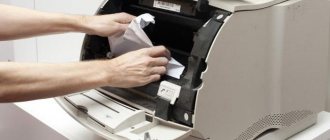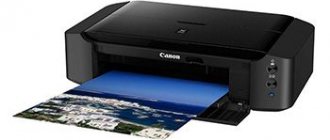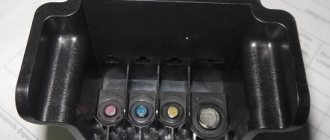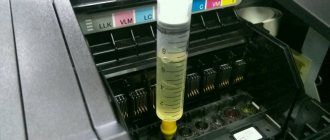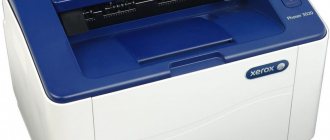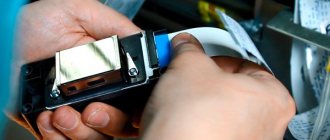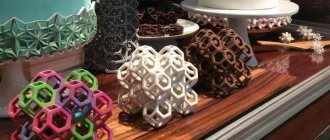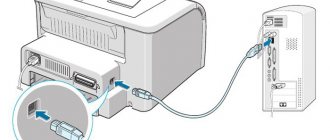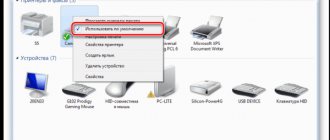Over the past couple of years there have been a lot of news about someone 3D printing something:
- hearing aid,
- milk products,
- House,
- robot finger,
- brain implants,
- statue of David 1 millimeter high,
- ready-made electronic devices.
Let's figure out how this technology works, what its limitations are, and whether it has a future.
FDM
Fused Deposition Modeling (FDM), also known as Filament Fused Fabrication (FFF), is the most popular and widespread type of 3D printing.
A standard FDM device works like a hot glue gun controlled by a robot, which is not surprising, since the development of FDM technology once began with experiments with hot glue. The plastic rod is pushed through a hot nozzle, where it melts, and when it emerges, it is laid out in layers. The process is repeated over and over again until the finished 3D object appears.
The only difference is that 3D printers do not use hot glue sticks, but plastic filament wound on spools.
The most common materials for FDM (FFF) are ABS and PLA plastics.
Plastic thread, also known as filament, is produced in such a form so that it can easily melt at a given temperature, but harden very quickly - after cooling by just a couple of degrees. This is what makes it possible to print 3D products with complex geometries with high precision.
Simply put, 3D printing differs from traditional 2D printing only in that it is repeated over and over again, creating layer after layer, one on top of the other. After all, thousands of layers form a 3D object.
FDM printer using the example of MakerBot Replicator 2
Which 3D printer is best for home use?
Looking ahead, we note that for now the cost of household 3D printers remains relatively high, but in the future we have every chance of seeing the technology become cheaper. Remember, when mobile phones came out, they were also only available to very rich people.
The purposes for using a home 3D printer can be absolutely anything: from simple pampering and getting acquainted with new technology to printing useful little things in the household and prototype models for business. In any case, when choosing, pay attention to the following key characteristics of the device:
- print resolution (print accuracy) – this is the minimum possible layer height that the printer can print. Resolution is expressed in micrometers (thousandth of a millimeter). The smaller the layer height, the less noticeable the transition between them will be, and the smoother the surface of the printed object will be. On the other hand, the smaller the layer, the more time the printer will need to print and the higher the load on all its elements. Resolution depends on the technology (SLA allows you to print more accurately than FDM), the accuracy of the print heads, software settings and the selected print material;
Samples with different layer thicknesses - The printing speed directly depends on the accuracy: the higher the accuracy, the lower the speed of growing the model.
- print area indicates the size of an object that can be printed on a printer. In other words, this is the area of possible reach of the print head along the horizontal axes X and Y, as well as along the vertical axis Z. Typically, the print area is expressed in three numbers - this is the height, length and width of a conventional parallelepiped (for example, 20 * 30 * 30 mm). For delta printers, the print area is shaped like a cylinder, so its height and diameter are indicated;
- type of plastic used for printing. In everyday life, it is plastics that are used, and these can be ABS and PLA plastics; some models can print with both types of materials. The ability to print with one or another type of plastic is explained by the presence or absence of a heated platform. If you have not yet decided what you will print with, then it is better to choose a model that supports the maximum number of materials;
- manufacturer country. European countries and the USA produce high-quality, but expensive devices, they are imported in small quantities, and service is difficult. Chinese devices are inexpensive, the quality often leaves much to be desired, but for having fun, these printers are fine. There are also Russian-made printers: with good quality, they offer the possibility of service.
Stereolithography
Stereolithography uses light to “grow” objects in a container of photopolymer resin. As with other 3D printing technologies, the product is formed layer by layer, here by curing a liquid photopolymer with light.
Stereolithography differs from FDM in that it produces more monolithic prints, even with the same specified layer thickness.
In the photo: FDM and SLA prints, the layer of both models is 0.1 mm.
The point is the difference in technology - photopolymer illumination produces more accurate layers than molten filament squeezed out of the nozzle of an FDM printer.
SLA and DLP are two types of stereolithography. SLA - laser stereolithography, DLP - digital projection. The difference between them is that in SLA the light source is a laser, while in DLP it is a projector.
Regardless of the technical features, the operating principle of SLA and DLP devices is similar. To start printing, you need to lower a special build platform into a container with liquid photopolymer resin.
The platform stops at a height of one layer from the bottom of the container. The printer's light source is illuminating. The liquid polymer, when exposed to light, becomes solid and adheres to the building platform. After this, the platform rises to the height of another layer and the process repeats.
SLA printer using Formlabs Form 2 as an example
SLA gives smoother surfaces compared not only to FDM, but also to DLP, which we will discuss later.
This happens because DLP projects layers with a picture of pixels, and the laser beam in SLA moves continuously, which gives a smooth, non-pixelated layer.
DLP uses a projector for the same purposes, and LED DLP uses an LCD display with ultraviolet backlighting. In these designs, light is projected onto the resin over the entire layer area at the same time, which gives a speed advantage when printing large objects with 100% infill is required - full layer exposure occurs faster than in SLA.
But when printing small or hollow objects, SLA is faster, since the intensity of illumination by the laser beam, and therefore the polymerization speed, is higher.
DLP printer using the example of SprintRay MoonRay S
How it works and prints
Operating principle
Creating a model
After assembly and configuration (calibration), you need to create a printable three-dimensional model in a 3D editor.
- 3D modeling . A model is created in a 3D modeling program. Large prototypes that do not fit into the printer chamber are divided into several smaller ones. The 3D model is sent to a slicer program to generate G-code.
- G code . Slicer is an application for automatically preparing a digital model in STL format for printing on a 3D printer - generating G-code. The slicer cuts the model into layers and describes the movements of the print head and its actions necessary to form the prototype. Based on the G-code, the printing carriage moves along a given path, and the nozzle applies the material at specified moments.
After printing starts, the device executes commands from the G-code.
SLS
The main advantage of the technology over FDM and SLA is that SLS printing does not require the creation of supporting structures, because the support material is the material surrounding the model - this allows you to print products of any shape, with any number of internal cavities, and fill the entire working volume of the printer with them. SLS printers handle a wide range of materials, and their prints are stronger than most FDM or stereolithography prints.
Due to their strength characteristics, parts printed on SLS printers can be used for practical purposes, and not just as prototypes and decorative elements.
To create an object, the device directs a laser at a layer of fine powder, fusing the particles together to form a layer of the product. Then, the device scatters the next portion of powder onto the surface of the finished layer and levels it out, and the laser melts it, creating the next layer of the product. The procedure is repeated until printing is completed. SLS printers have one downside - their cost. They are very expensive compared to FDM and SLA/DLP. This is due to the price of the high-energy lasers required for such printing. In principle, the cost of even the cheapest SLS printers recently started at $200,000. However, some companies are currently working to make this technology more affordable, so there is a chance that they will be able to purchase an SLS printer in the near future Even amateurs can afford it. One example is the Polish company Sinterit.
SLS printer using the example of Sinterit Lisa Pro
The model removed from the SLS printer does not require removal of supports and can be used without post-processing; it only needs to be cleaned of excess powder.
3D printing business at home
The revolutionary printing device greatly increases the opportunities for self-realization for people of art. Many designers and artists are able to realize their potential by creating 3D images on a computer. And if the owner has a home 3D printer, then you can easily start earning money and receive significant profits from an interesting activity. Modern modeling amazes viewers; creativity becomes a way to implement business projects.
Note! At home, volumetric printing is most in demand, because not everyone has such a printer nearby. Therefore, it is worth opening a group on a social network and selling images of finished goods to neighbors or townspeople.
What can be done with a 3D printer:
- Sketches of weapons and items for computer games;
- Video game action figures;
- Children's cars and parts for construction kits;
- Lots of trinkets;
- Camera lens;
- Robots and mechanical components:
- Furniture and toys;
- Cars;
- Fountains and building examples;
- Clothes and shoes;
- Accessories;
- Household items including spoons and forks.
- Dishes;
- Chandeliers.
Polyjet
The main advantage of Polyjet technology is its multimateriality - many Polyjet printers are capable of printing an object with a large number of different materials at the same time, which allows you to create products consisting of sections with different mechanical and optical properties, that is, different hardness and color. This is proprietary technology ]Stratasys[/anchor].
Example: a Stratasys printer and sneakers printed on it.
Polyjet 3D printers spray tiny droplets of photopolymer resin onto a surface and cure them with ultraviolet light.
This process is repeated until the object is created. Unlike FDM printers, Polyjet devices can deposit material from multiple nozzles simultaneously.
Polyjet printer using the Stratasys J750 as an example
A little history of 3D printers
Despite the fact that 3D printing technology has only been on everyone’s lips for the last few years, its appearance is worth looking for back in the last century. A pioneer in this area was the Charles Hull company, which developed 3D printing technology in 1984, and a little later patented the stereolithography technique, which is used everywhere today. At the same time, the company developed and created the first industrial three-dimensional printer, which actually marked the beginning of a new era.
The 90s saw the emergence of new developments in the field of three-dimensional printing, thanks to which 3D printers found application in production environments and began to be used for prototyping. The peak of technology development is in the 21st century, and we ourselves are witnessing how 3D printing is conquering new heights by leaps and bounds. Today, printing can be done with a variety of materials, not only plastics and metal , but also fabric, paper, ceramics, food and even living cells.
In 2005, it became possible to print in color, and in 2006, a printer was created that can print about half of all its own components. In 2014, the first printers appeared with a print area that was practically unlimited in size. Using this device, they have already tried to create a full-fledged house using concrete as the main material. The construction of such a structure took no more than a day. Already in 2021, the first building built using 3D printing in Dubai. In February 2021, Russia also unveiled a house printed entirely on a construction site. This year also saw the development of a six-axis printer that will make complex parts much easier to print without the need for support structures. At the moment, the development of printers that can print human organs, prostheses, implants, car bodies and even food is in full swing.
